HONDA CR-V 2004 RD4-RD7 / 2.G User Guide
Manufacturer: HONDA, Model Year: 2004, Model line: CR-V, Model: HONDA CR-V 2004 RD4-RD7 / 2.GPages: 256, PDF Size: 2.96 MB
Page 11 of 256
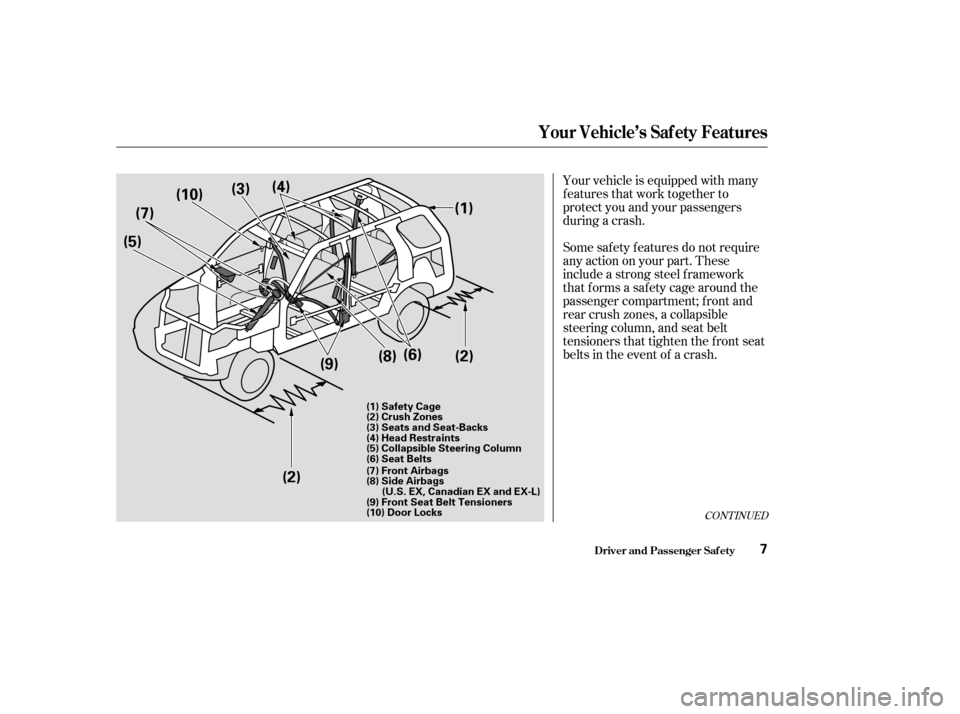
Your vehicle is equipped with many
features that work together to
protect you and your passengers
during a crash.
Some saf ety f eatures do not require
anyactiononyourpart.These
include a strong steel f ramework
that forms a safety cage around the
passenger compartment; f ront and
rear crush zones, a collapsible
steering column, and seat belt
tensioners that tighten the front seat
belts in the event of a crash.
CONT INUED
Your Vehicle’s Saf ety Features
Driver and Passenger Saf ety7
(5)(7)
(10)
(3)
(4)
(1)
(2)
(9) (8)
(6)
(2)
(7) Front Airbags
(8) Side Airbags (U.S. EX, Canadian EX and EX-L)
(9) Front Seat Belt Tensioners
(10) Door Locks (1) Safety Cage
(2) Crush Zones
(3) Seats and Seat-Backs
(4) Head Restraints
(5) Collapsible Steering Column
(6) Seat Belts
Page 12 of 256

However, you and your passengers
can’t take f ull advantage of these
saf ety f eatures unless you remain
sitting in a proper position and
always wear your seat belts properly.
Infact,somesafetyfeaturescan
contribute to injuries if they are not
used properly.
The f ollowing pages explain how you
cantakeanactiveroleinprotecting
yourself and your passengers.Your vehicle is equipped with seat
belts in all seating positions.
Your seat belt system also includes a
light on the instrument panel to
remind you and your passengers to
f asten your seat belts.
Seat belts are the single most
ef f ective saf ety device f or adults and
larger children (Inf ants and smaller
children must be properly restrained
in child seats).
Not wearing a seat belt properly
increases the chance of serious
injury or death in a crash, even
though your vehicle has airbags.
In addition, most states and all
Canadian provinces require you to
wear seat belts.
Your Vehicle’s Saf ety Features
Seat BeltsWhy Wear Seat Belt s
Driver and Passenger Saf ety8
Page 13 of 256
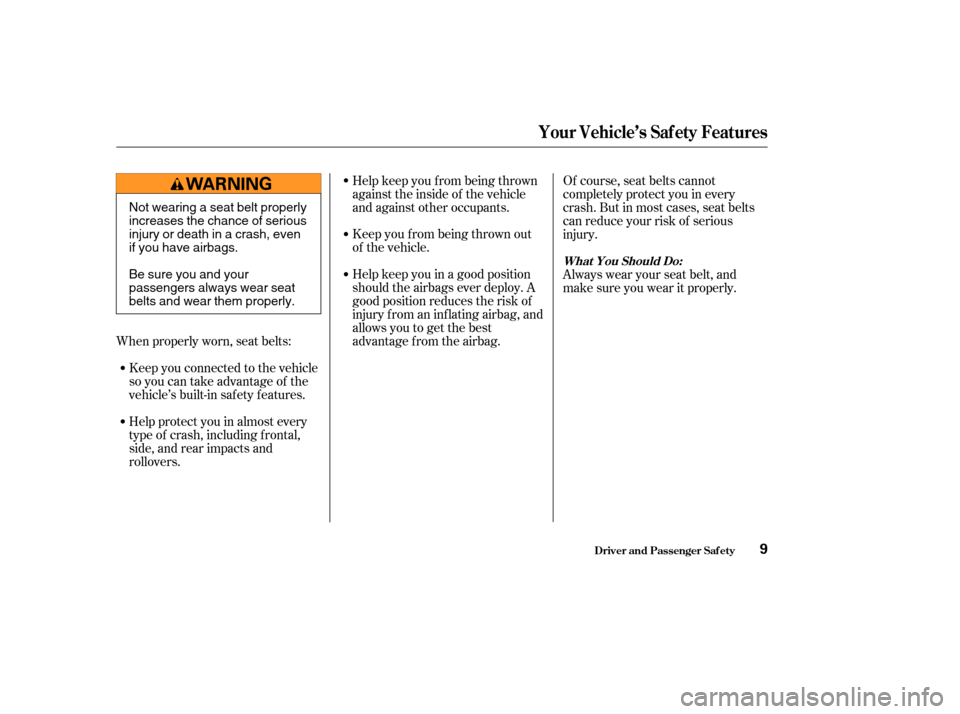
When properly worn, seat belts:Help protect you in almost every
type of crash, including f rontal,
side, and rear impacts and
rollovers. Help keep you f rom being thrown
against the inside of the vehicle
and against other occupants.
Keep you f rom being thrown out
of the vehicle.
Help keep you in a good position
should the airbags ever deploy. A
good position reduces the risk of
injury f rom an inf lating airbag, and
allows you to get the best
advantage f rom the airbag.
Of course, seat belts cannot
completely protect you in every
crash.Butinmostcases,seatbelts
can reduce your risk of serious
injury.
Always wear your seat belt, and
make sure you wear it properly.
Keep you connected to the vehicle
so you can take advantage of the
vehicle’s built-in saf ety f eatures.
Your Vehicle’s Saf ety Features
Driver and Passenger Saf ety
What You Should Do:
9
Not wearing a seat belt properly
increases the chance of serious
injury or death in a crash, even
if you have airbags.
Be sure you and your
passengers always wear seat
belts and wear them properly.
Page 14 of 256
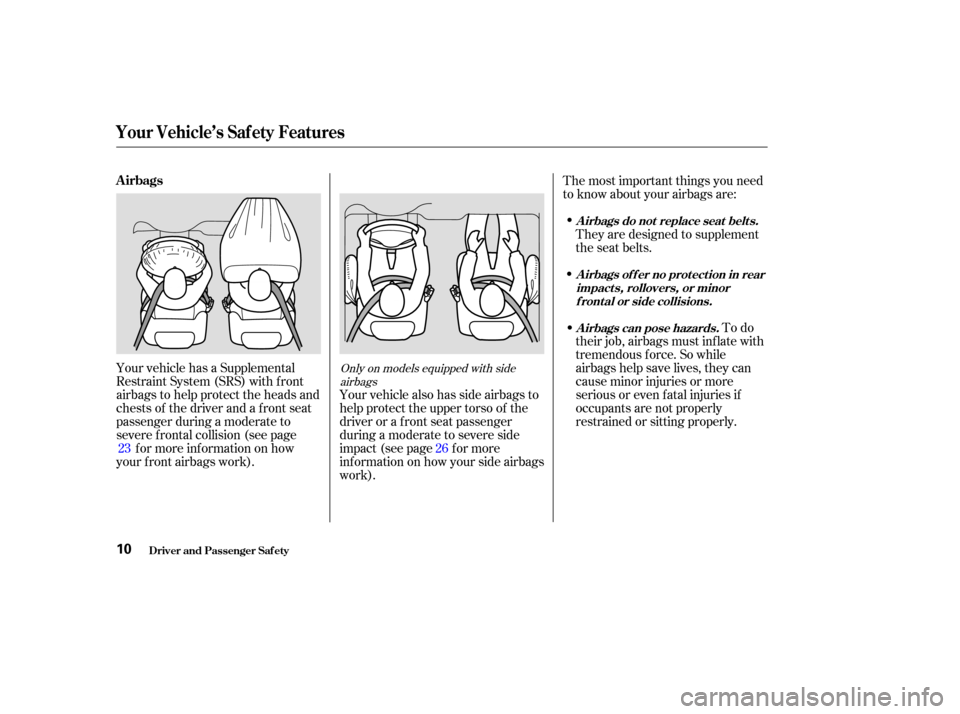
Your vehicle has a Supplemental
Restraint System (SRS) with f ront
airbags to help protect the heads and
chests of the driver and a front seat
passenger during a moderate to
severe f rontal collision (see pagef or more inf ormation on how
your f ront airbags work). Your vehicle also has side airbags to
help protect the upper torso of the
driver or a f ront seat passenger
during a moderate to severe side
impact (see page f or more
information on how your side airbags
work).The most important things you need
to know about your airbags are:
They are designed to supplement
the seat belts.
To do
their job, airbags must inf late with
tremendous f orce. So while
airbags help save lives, they can
cause minor injuries or more
serious or even fatal injuries if
occupants are not properly
restrained or sitting properly.
23 26Only on models equipped with side
airbags
Your Vehicle’s Saf ety Features
Driver and Passenger Saf ety
Airbags
Airbags do not replace seat belts.
A irbags can pose hazards.
A irbags of f er no prot ect ion in rear
impact s, rollovers, or minorf ront al or side collisions.
10
Page 15 of 256

Always wear your seat belt properly,
sit upright, and as far back from the
steering wheel while allowing f ull
control of the vehicle. A f ront
passenger should move their seat as
f ar back f rom the dashboard as
possible.
Your Vehicle’s Saf ety Features
Driver and Passenger Saf ety
What You Should Do:
11
Page 16 of 256
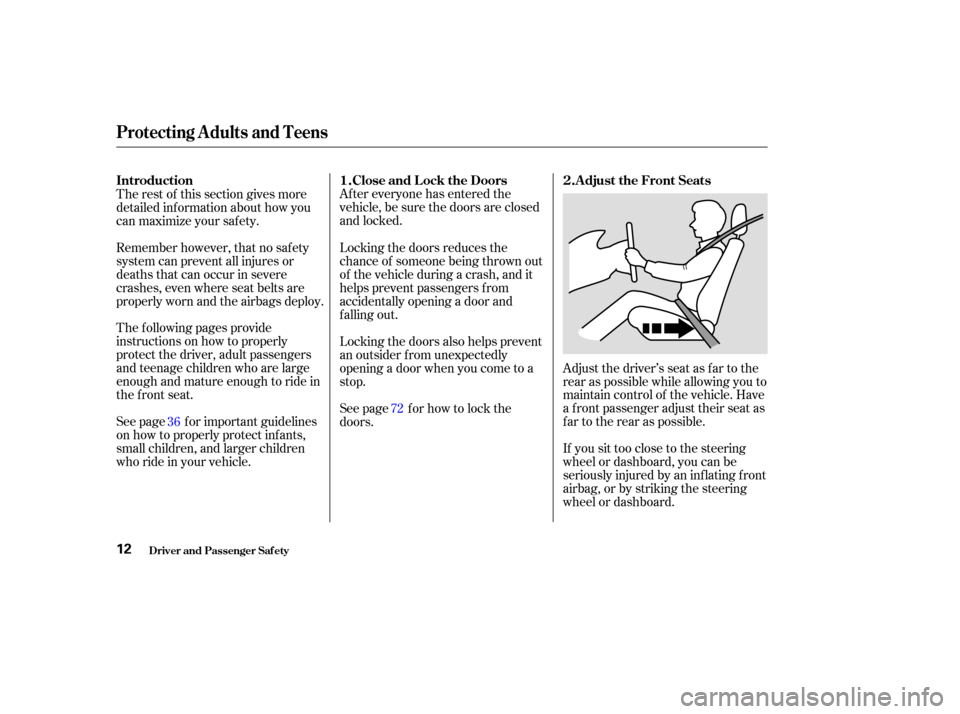
Af ter everyone has entered the
vehicle, be sure the doors are closed
and locked.If you sit too close to the steering
wheel or dashboard, you can be
seriously injured by an inf lating f ront
airbag, or by striking the steering
wheel or dashboard.
See page f or important guidelines
on how to properly protect inf ants,
small children, and larger children
who ride in your vehicle. The f ollowing pages provide
instructions on how to properly
protect the driver, adult passengers
and teenage children who are large
enough and mature enough to ride in
the front seat. Remember however, that no saf ety
system can prevent all injures or
deaths that can occur in severe
crashes, even where seat belts are
properly worn and the airbags deploy. The rest of this section gives more
detailed inf ormation about how you
can maximize your saf ety.
Locking the doors reduces the
chance of someone being thrown out
of the vehicle during a crash, and it
helps prevent passengers f rom
accidentally opening a door and
f alling out.
Adjust the driver’s seat as far to the
rear as possible while allowing you to
maintain control of the vehicle. Have
a f ront passenger adjust their seat as
far to the rear as possible.
Locking the doors also helps prevent
an outsider f rom unexpectedly
opening a door when you come to a
stop.
See page f or how to lock the
doors.
36 72
Protecting A dults and Teens
Driver and Passenger Saf ety
Close and L ock the Doors
A djust the Front Seats
Introduction 1.2.
12
Page 17 of 256
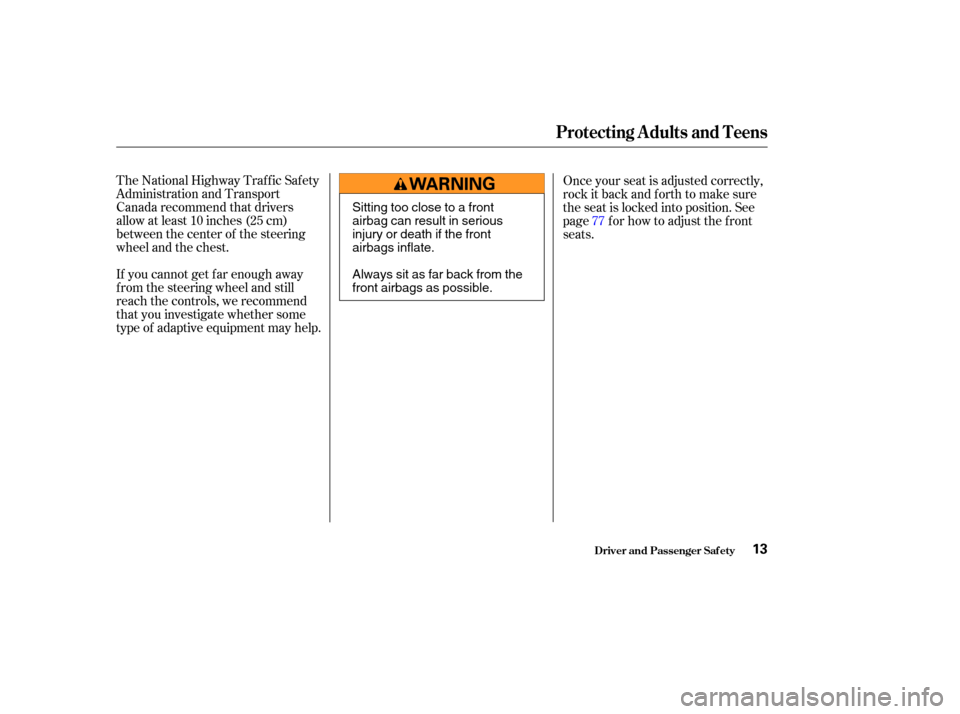
The National Highway Traffic Safety
Administration and Transport
Canada recommend that drivers
allow at least 10 inches (25 cm)
between the center of the steering
wheel and the chest.
If you cannot get f ar enough away
f rom the steering wheel and still
reach the controls, we recommend
that you investigate whether some
type of adaptive equipment may help.Once your seat is adjusted correctly,
rock it back and f orth to make sure
the seat is locked into position. See
page f or how to adjust the f ront
seats.
77
Protecting A dults and Teens
Driver and Passenger Saf ety13
Sitting too close to a front
airbag can result in serious
injury or death if the front
airbags inflate.
Always sit as far back from the
front airbags as possible.
Page 18 of 256
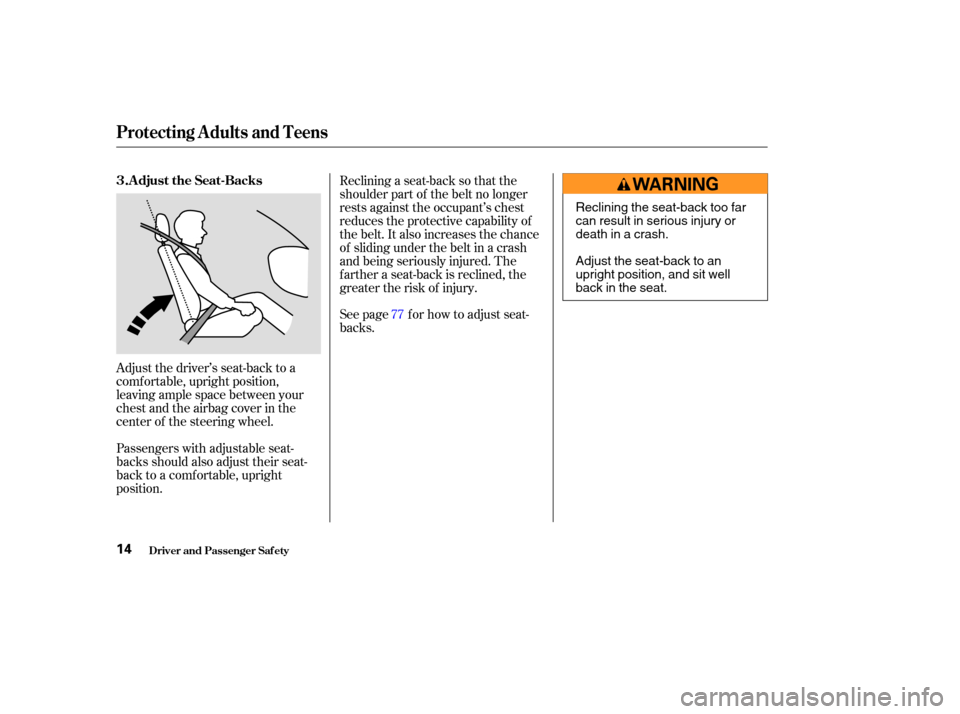
Adjust the driver’s seat-back to a
comf ortable, upright position,
leaving ample space between your
chest and the airbag cover in the
center of the steering wheel.
Passengers with adjustable seat-
backs should also adjust their seat-
back to a comf ortable, upright
position.Reclining a seat-back so that the
shoulder part of the belt no longer
rests against the occupant’s chest
reduces the protective capability of
the belt. It also increases the chance
of sliding under the belt in a crash
and being seriously injured. The
farther a seat-back is reclined, the
greater the risk of injury.
See page f or how to adjust seat-
backs.
77
Protecting A dults and Teens
Driver and Passenger Saf ety
Adjust the Seat-Backs
3.
14
Reclining the seat-back too far
can result in serious injury or
death in a crash.
Adjust the seat-back to an
upright position, and sit well
back in the seat.
Page 19 of 256
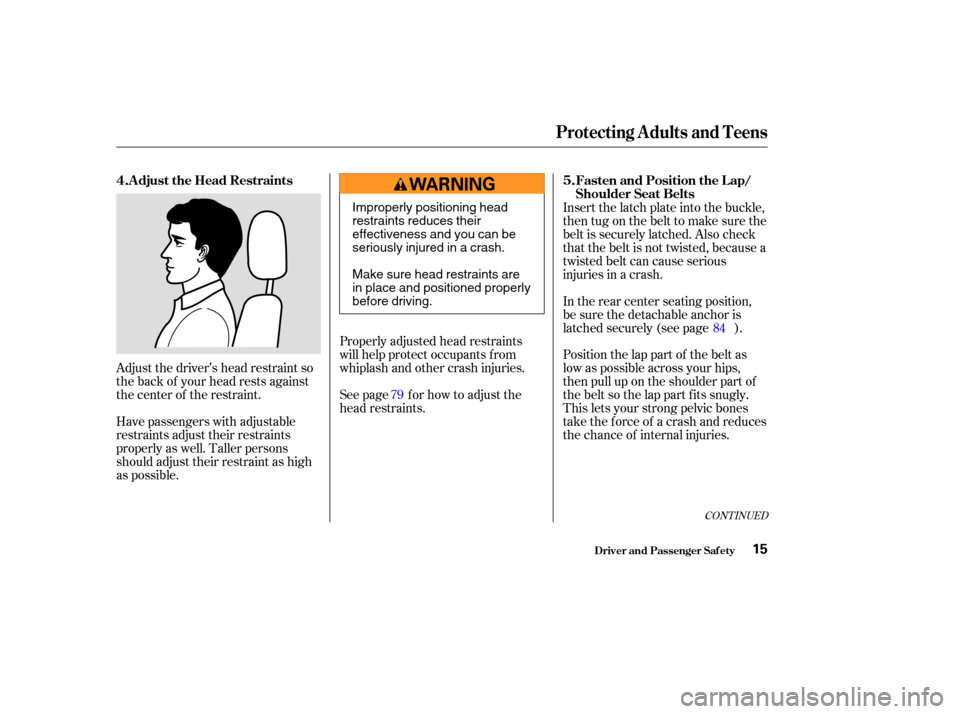
Adjust the driver’s head restraint so
the back of your head rests against
the center of the restraint.
Have passengers with adjustable
restraints adjust their restraints
properly as well. Taller persons
should adjust their restraint as high
as possible.Properly adjusted head restraints
will help protect occupants f rom
whiplash and other crash injuries.
See page f or how to adjust the
head restraints.Insert the latch plate into the buckle,
then tug on the belt to make sure the
belt is securely latched. Also check
that the belt is not twisted, because a
twisted belt can cause serious
injuries in a crash.
Position the lap part of the belt as
low as possible across your hips,
then pull up on the shoulder part of
thebeltsothelappartfitssnugly.
This lets your strong pelvic bones
take the force of a crash and reduces
the chance of internal injuries. In the rear center seating position,
be sure the detachable anchor is
latched securely (see page ).
79 84
CONT INUED
Protecting A dults and Teens
Driver and Passenger Saf ety
Adjust the Head Restraints
Fasten and Position the Lap/
Shoulder Seat Belts
4.
5.
15
Improperly positioning head
restraints reduces their
effectiveness and you can be
seriously injured in a crash.
Make sure head restraints are
in place and positioned properly
before driving.
Page 20 of 256
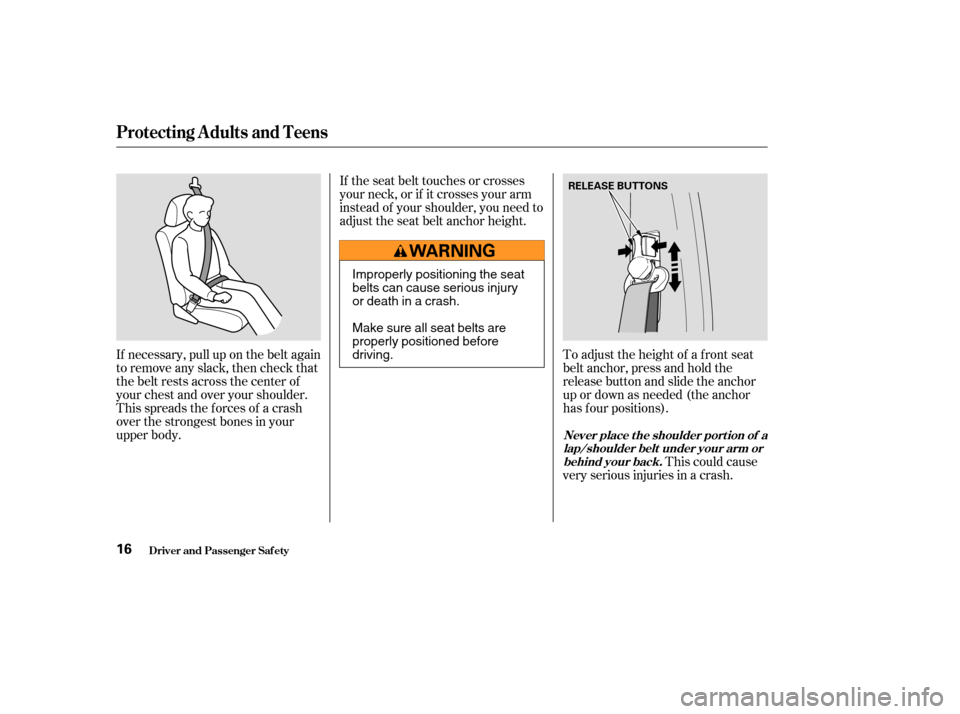
If necessary, pull up on the belt again
to remove any slack, then check that
the belt rests across the center of
your chest and over your shoulder.
This spreads the f orces of a crash
over the strongest bones in your
upper body.If the seat belt touches or crosses
your neck, or if it crosses your arm
instead of your shoulder, you need to
adjust the seat belt anchor height.
To adjust the height of a f ront seat
belt anchor, press and hold the
release button and slide the anchor
up or down as needed (the anchor
has f our positions).This could cause
very serious injuries in a crash.
Protecting A dults and Teens
Driver and Passenger Saf ety
Never place t he shoulder port ion of a
lap/shoulder belt under your arm orbehind your back.
16
RELEASE BUTTONS
Improperly positioning the seat
belts can cause serious injury
or death in a crash.
Make sure all seat belts are
properly positioned before
driving.